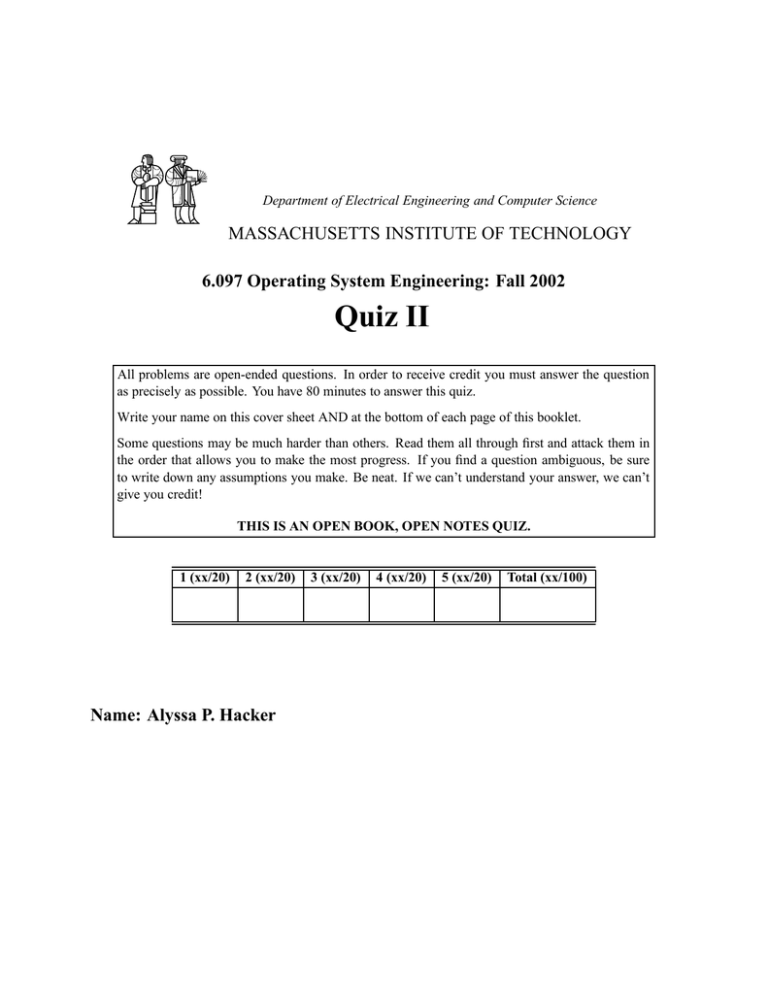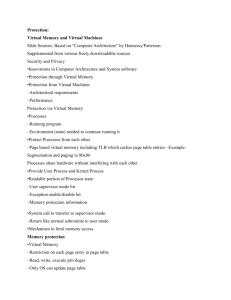Quiz II MASSACHUSETTS INSTITUTE OF TECHNOLOGY 6.097 Operating System Engineering: Fall 2002
advertisement

Department of Electrical Engineering and Computer Science
MASSACHUSETTS INSTITUTE OF TECHNOLOGY
6.097 Operating System Engineering: Fall 2002
Quiz II
All problems are open-ended questions. In order to receive credit you must answer the question
as precisely as possible. You have 80 minutes to answer this quiz.
Write your name on this cover sheet AND at the bottom of each page of this booklet.
Some questions may be much harder than others. Read them all through first and attack them in
the order that allows you to make the most progress. If you find a question ambiguous, be sure
to write down any assumptions you make. Be neat. If we can’t understand your answer, we can’t
give you credit!
THIS IS AN OPEN BOOK, OPEN NOTES QUIZ.
1 (xx/20)
2 (xx/20)
Name: Alyssa P. Hacker
3 (xx/20)
4 (xx/20)
5 (xx/20)
Total (xx/100)
6.097 FALL 2002, Quiz 2 Solutions
Page 2 of 10
I Fast mutual exclusion
A common way to implement concurrent inserts is using an atomic TSL (Test-Set-and-Lock) instruction:
List *list = NULL;
int insert_lock = 0;
insert(int data) {
/* acquire the lock: */
while(TSL(&insert_lock) != 0)
;
/* critical section: */
List *l = new List;
l->data = data;
l->next = list;
list = l;
/* release the lock: */
insert_lock = 0;
}
Many processors support an atomic cmpxchg instruction. This instruction has the following semantics:
int cmpxchg(addr, v1, v2) {
int ret = 0;
// stop all memory activity and ignore interrupts
if (*addr == v1) {
*addr = v2;
ret = 1;
}
// resume other memory activity and take interrupts
return ret;
}
Name:
6.097 FALL 2002, Quiz 2 Solutions
Page 3 of 10
1. [5 points]: Give an implementation of insert using the cmpxchg instruction.
insert (int data) {
List *l = new List;
l->data = data;
do {
l->next = list;
} while (!cmpxchg (&list, l->next, l));
}
2. [5 points]: Why is the implementation of insert with cmpxchg preferable over the one with
TSL?
The cmpxchg version is wait free. There is no chance for a deadlock because there are no locks.
Name:
6.097 FALL 2002, Quiz 2 Solutions
Page 4 of 10
3. [5 points]: Give an implementation of cmpxchg using a restartable atomic sequence.
int cmpxchg_RAS(addr, v1, v2) {
int ret = 0;
BEGIN RAS
if (*addr == v1) {
*addr = v2;
END RAS
ret = 1;
}
return ret;
}
4. [5 points]: Can you extend the insert() routine to insert nodes into a doubly linked list using
cmpxchg and without using locks? If so, give the code, otherwise explain why not.
struct List {
List *next;
List *prev;
int data;
};
You can not just use cmpxchg to insert into a doubly linked list because the insert into list operations:
insert(int data) {
// Prepare new element
List *l = new List;
l->data = data;
l->prev = NULL;
// Insert into list
l->next = list;
list->prev = l;
list = l;
}
require two externaly visible memory writes. Even if cmpxchg is used for the first externally visible write,
the process may be descheduled/interrupted before the second write. The first write will still be globally
visible and would lead to an inconsistent list if another insert occurred.
Name:
6.097 FALL 2002, Quiz 2 Solutions
Page 5 of 10
II Soft updates
The pseudocode for the flusher described in the soft-updates paper is as follows (b is a block):
flushblock (b)
{
lock b;
for all dependencies that b depends on
"remove" that dependency by undoing the change to b
mark the dependency as "unrolled"
write b
}
write_completed (b) {
remove dependencies that depend on b.
reapply "unrolled" dependencies that b depended on
unlock b
}
Ben proposes another implementation. Instead of unrolling dependencies, Ben’s implementation removes
the dependencies by first flushing the block b’ that b depends on and the blocks that b’ depends on:
flushblock (b)
{
lock b;
for each block b’ that b depends on
flushblock (b’);
write b
}
write_completed (b) {
unlock b
}
Name:
6.097 FALL 2002, Quiz 2 Solutions
Page 6 of 10
5. [5 points]: Draw a set of inode and data blocks and their dependencies that show that Ben’s code
is wrong. Why is Ben’s code wrong?
Dependencies exist in the filesystem at a finer granularity than blocks. For example, multiple directory
entries exist in a single block. As such, a circular dependency can exist between two blocks. However, since
the flusher can only flush entire blocks, the presence of a circular dependency will result in an infinite loop
in Ben’s code.
One possible picture is taken from the paper (Figure 1). An alternative is given below:
Inode
Inode # 1
data block for current directory
< ’f’, # 2 >
Inode # 2
..
.
6. [5 points]: List a sequence of system calls that can lead to the drawing that you provided as an
answer to the previous question.
Assume a process executes the following calls in a single empty directory d:
creat(’f’); // directory data block depends on file inode block
// directory inode block depends on directory data block
Suppose f and d have inodes on the same block.
Name:
6.097 FALL 2002, Quiz 2 Solutions
Page 7 of 10
Ben proposes yet another implementation. This implementation removes the dependencies by first writing
(instead of flushing) the block that b is depending on:
flushblock (b)
{
lock b;
for each block b’ that b depends on
write (b’);
write b
}
write_completed (b) {
unlock b
}
7. [5 points]: Give a timeline of system calls and failures that results in incorrect behavior with this
last implementation.
Any sequence of events where there is a circular dependency will result in such a case. Imagine:
user:
creat(’a’) //
kernel: flush (b) //
write b’ //
CRASH
write b
//
as above
b is inode block of ’a’ and cwd
b’ is data block of cwd
never happens!
The block b� with its data that depends on b will be incorrectly written on disk.
Name:
6.097 FALL 2002, Quiz 2 Solutions
Page 8 of 10
III Mach VM system
Assume a UNIX process that is running in an address space with 3 objects: one object for the read-only text
of the program “a.out”, one read-write, private data object (initialized from “a.out”), and one object for a
read/write stack.
8. [10 points]: Draw a picture that shows the vm map entries for this process, and to which objects
they are pointing. Give a brief justification for your picture.
(Hint: include the shadow objects)
TEXT
DATA
STACK
FILE
SHADOW
ANON
FILE
9. [10 points]: Now “a.out” forks. Draw a picture that shows the vm map entries for both pro­
cesses, and to which objects they are pointing. Give a brief justification for your picture.
TEXT
DATA
STACK
FILE
SHADOW
SHADOW
SHADOW
FILE
Name:
ANON
TEXT
DATA
STACK
SHADOW
SHADOW
6.097 FALL 2002, Quiz 2 Solutions
Page 9 of 10
IV Virtualizing traps and interrupts in the x86
In a hosted virtual machine monitor, a host operating system serves runs the VMM as an application (pro­
cess) with full privileges (e.g. ring 0 on the x86). The VMM then runs the guest operating system inside a
virtual machine. In order to do so successfully, the VMM must employ a variety of techniques to prevent
the guest from discerning that it is in a virtual machine.
Ben is working on a hosted x86 virtualizer but he can’t figure out how to virtualize interrupts and traps. Can
you come up with a solution? (Hint: read all questions in this section first to better understand the
issues involved.)
10. [5 points]: What IDT should the CPU use when it is executing instructions of the guest operating
system? Is it the IDT of the host, the guest, or something else constructed by the VMM? Explain.
Here is one possible answer. We assume that there is no special support in the kernel besides allowing the
VMM to load code that will run at ring 0. (Another possibility might be to have an exo-kernel style host
operating system that allows user programs to hook into receiving notification about generic system traps.)
While the guest operating system is running, the VMM will have installed a special IDT installed that is
neither the host or the guest’s. This is necessary to allow the VMM to handle CPU virtualization related
exceptions correctly.
11. [5 points]: What state should the VMM maintain in order to virtualize interrupts and traps?
When is this state updated?
In addition to the general CPU state that must be maintained for regular CPU virtualization (e.g. general
purpose registers), the VMM must maintain state about both the host operating system IDT, which it will
save when it switches out the IDT before starting the guest OS, and the guest OS’s desired IDT, which it will
save when the guest runs lidt. In the case of the guest, the VMM should probably only keep a pointer to
where the guest is keeping to IDT in order to avoid having to trap when the guest writes to the page where
the IDT is stored.
Name:
6.097 FALL 2002, Quiz 2 Solutions
Page 10 of 10
12. [5 points]: Interrupts can be generated by hardware or by instructions that are being executed by
the guest. How should the VMM handle hardware interrupts? When does the guest operating system
receive an interrupt? (Hint: The VMM relies on the host for actual device driver support.)
Under this scheme, the VMM should immediately forward all hardware interrupts back to the host operating
system. The trap frame will allow the VMM to quickly save the guest operating system’s basic state, and
then the other CPU state should be saved as well. Then the VMM should place the trap on the host operating
system’s TSS and jump the host OS’s trap handler.
The guest operating system will only receive an interrupt when the VMM decides there is some sort of
interrupt that the guest should get. For example, the VMM may choose to forward clock interrupts on to
the guest operating system. For device I/O, the VMM will create interrupts for the guest when it receives
notification from the host operating system that there is data to be provided to the guest.
Note! Calls to outb from the guest will result in traps and these will be emulated by the VMM with
read/write calls to the host OS. The VMM should not attempt to determine if a particular interrupt is “for”
the guest. This would only apply if a device were completely dedicated to the guest OS and the host OS was
not allowed to use it at all.
13. [5 points]: How should the VMM handle traps that are generated by the guest (e.g. intentionally,
by a system call or indirectly, as a result of the CPU virtualization)?
Errors like divide by zero or break point interrupts should be directly forwarded back into the guest operating
system, using knowledge of the guest’s IDT.
CPU virtualization traps and system calls will appear as GPFs since the VMM IDT is configured not to
allow the int instruction to generate any interrupts from ring 3 or execute any privilegd instructions. The
error code and instruction will allow the VMM to decide which of these two cases occurred. If the problem
is the result of CPU virtualization (e.g. lidt executed in guest), the VMM must emulate the instruction
and then continue. Otherwise, the VMM should simply forward the trap on to the guest.
End of Quiz II—-Thanks and enjoy a
well-deserved break!
Name:
MIT OpenCourseWare
http://ocw.mit.edu
6.828 Operating System Engineering
Fall 2012
For information about citing these materials or our Terms of Use, visit: http://ocw.mit.edu/terms.


